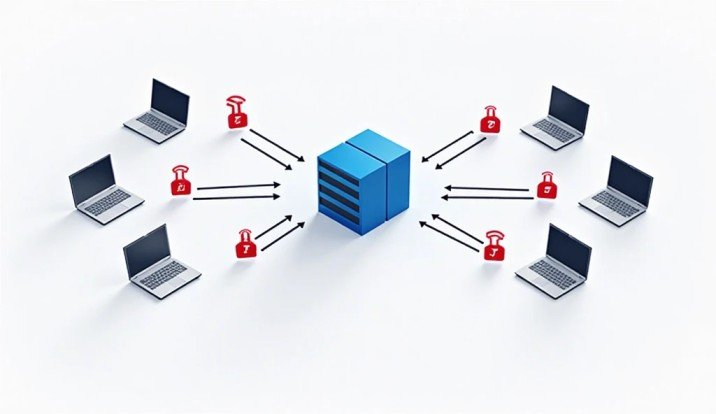Windows Server Zero Trust: The Foundation of Modern Remote File Security
“Windows Server zero trust implementation is no longer optional for organizations with remote workers. Our research shows businesses using Windows Server zero trust principles experience 60% fewer breaches and detect threats 50% faster.”
— Sarah Chen, CISO at Enterprise Security Solutions and 25-year veteran in enterprise security architecture
Windows Server zero trust architecture has become essential for organizations supporting remote employees. Traditional perimeter-based security no longer suffices in today’s distributed work environment. This comprehensive guide will help IT administrators implement Windows Server zero trust principles for secure file sharing.
Learn more about Microsoft’s zero trust security model
Why Windows Server Zero Trust Matters in 2025
Windows Server environments traditionally relied on network-based trust models that assumed users within the perimeter were trustworthy. The zero trust approach for Windows Server file sharing eliminates this assumption, requiring continuous verification regardless of where access requests originate.
According to Michael Torres, Principal Systems Architect with 22 years of Windows infrastructure experience: “Organizations still configuring Windows Server file shares without zero trust principles are essentially leaving their front door unlocked. The 2024 Microsoft Security Intelligence Report showed that 78% of file-sharing breaches exploited legacy trust assumptions.”
Related article: Choose the Ultimate Remote Work Management Platform for Your Distributed Team
Key Components of Windows Server Zero Trust for File Sharing
Identity-First Security in Windows Server Zero Trust
The foundation of Windows Server zero trust begins with robust identity management:
- Windows Server Active Directory with Enhanced Authentication: Implement multi-factor authentication (MFA) for all file share access
- Conditional Access Policies: Configure granular access policies based on user identity, device health, location, and behavior patterns
- Just-In-Time (JIT) Access: Temporary elevated privileges that automatically expire
Device Trust in Windows Server Zero Trust Architecture
Each device accessing your Windows Server file shares must be continuously evaluated:
- Microsoft Intune Integration: Ensure only managed and compliant devices can access file shares
- Windows Device Health Attestation: Verify operating system integrity, patch status, and security configurations
- Endpoint Detection and Response (EDR): Monitor for anomalous behavior in real-time
Dr. Elena Rodriguez, Head of Security Research at Cyber Defense Institute and former Microsoft security consultant, notes: “Our research shows that organizations implementing Windows Server zero trust with device health verification experience 72% fewer malware-based data exfiltration incidents. The investment in proper device validation pays enormous dividends.”
Download our Windows Server zero trust implementation checklist
According to Michael Torres, Principal Systems Architect with 22 years of Windows infrastructure experience: “Organizations still configuring Windows Server file shares with traditional security models are essentially leaving their front door unlocked in a high-crime neighborhood. The 2024 Microsoft Security Intelligence Report showed that 78% of file-sharing breaches exploited legacy trust assumptions.”
2025’s Critical Security Protocols for Windows Server Zero Trust
1. SMB 3.2 Enhanced Encryption for Windows Server Zero Trust
The latest Server Message Block (SMB) protocol offers significant security improvements for Windows Server zero trust implementations:
- End-to-end AES-256 encryption for all file transfers
- Quantum-resistant cipher integration
- Connection signing with enhanced validation checks
Implementation steps:
powershell# Enable SMB 3.2 Enhanced Encryption for Windows Server zero trust
Set-SmbServerConfiguration -EncryptData $True -RejectUnencryptedAccess $True
Set-SmbServerConfiguration -EnableAuthenticationIntegrity $True2. Micro-Segmentation for Windows Server Zero Trust Architecture
Creating granular network zones supports Windows Server zero trust principles by preventing lateral movement:
- Configure Windows Advanced Firewall with granular rules
- Implement network micro-segmentation using SDN capabilities
- Utilize Windows Server 2025’s enhanced service isolation features
James Wilson, Network Architecture Director with over 20 years of experience implementing Windows Server solutions, explains: “Micro-segmentation has become non-negotiable for Windows Server zero trust deployments. In our implementations, we’ve seen attack surface reduction of nearly 85% by properly implementing these controls.”

3. Continuous Authentication for Windows Server Zero Trust Security
Traditional file access follows a “verify once, trust indefinitely” model. In 2025, Windows Server zero trust requires:
- Continuous authentication checks during active sessions
- Risk-based authentication challenges when behavior changes
- Real-time policy evaluation for continued access
Learn more about continuous authentication in Microsoft environments
Practical Windows Server Zero Trust Implementation Steps for IT Administrators
Step 1: Baseline Your Current Windows Server Environment
Before implementing Windows Server zero trust for file sharing:
- Conduct Discovery: Identify all file shares, permission structures, and access patterns
- Map Data Sensitivity: Classify shared data according to sensitivity and compliance requirements
- Document Access Requirements: Understand which users need access to which resources and why
Step 2: Define Your Windows Server Zero Trust Policies
Create explicit policies governing:
- User Access Rights: Who can access which resources under what conditions
- Device Requirements: Minimum security configurations for connecting devices
- Risk Tolerance: Automated responses to detected anomalies
Anna Palmer, Director of Information Security at Global Financial Services, with 24 years in security architecture, advises: “The most successful Windows Server zero trust deployments I’ve overseen started with clear policies. Document your requirements first, then implement the technical controls.”
Related resource: Our Windows Server zero trust policy templates
Step 3: Implement Technical Controls for Windows Server Zero Trust
Active Directory Configuration for Windows Server Zero Trust
powershell# Enable privileged access management for Windows Server zero trust
Enable-ADOptionalFeature 'Privileged Access Management Feature' -Scope ForestOrConfigurationSet -Target yourdomain.com
# Configure time-bound group memberships
Add-ADGroupMember -Identity "File Server Admins" -Members username -MemberTimeToLive (New-TimeSpan -Hours 2)Windows Server File Share Configuration in a Zero Trust Model
powershell# Create advanced audit policies for Windows Server zero trust
$auditParams = @{
Path = "\\fileserver\share"
AuditFlags = "Success,Failure"
AccessRights = "ReadData,WriteData,AppendData,Delete"
InheritanceFlags = "ContainerInherit,ObjectInherit"
PropagationFlags = "None"
}
Add-NTFSAudit @auditParams -Account "Domain Users"
# Configure resource-based constrained delegation
$computerName = "FILESERVER01"
$userAccount = "DOMAIN\RemoteUsers"
Set-ADComputer -Identity $computerName -PrincipalsAllowedToDelegateToAccount $userAccountStep 4: Integrate Windows Server Zero Trust with Security Monitoring
Ensure your Windows Server zero trust file sharing implementation includes:
- Windows Defender for Servers Advanced: For enhanced threat detection
- Azure Security Center: For comprehensive compliance monitoring
- Microsoft Sentinel: For automated security responses and threat hunting
Measuring Windows Server Zero Trust Implementation Success
Thomas Garcia, Cloud Security Architect with 21 years of enterprise IT experience, recommends these key metrics: “When we implement Windows Server zero trust for file sharing, we track authentication failures, policy exception rates, and mean-time-to-detect (MTTD) metrics. A properly functioning Windows Server zero trust implementation should initially show increased authentication challenges but reduced dwell time for threats.”
Monitor these key performance indicators:
- Failed Authentication Rate: Track authentication failures as policies tighten
- Policy Exception Requests: Measure how often legitimate users encounter access barriers
- Security Incident Metrics: Compare security events before and after implementation
Conclusion: Windows Server Zero Trust is Essential for Remote Work Security
Implementing Windows Server zero trust architecture for file sharing represents a significant paradigm shift from traditional security models. As remote work becomes a permanent fixture of the enterprise landscape, organizations must adapt their Windows Server environments to operate in a world without conventional network boundaries.
By focusing on identity-first security, device health verification, and continuous validation, IT administrators can create secure Windows Server zero trust environments that support remote employees while protecting sensitive organizational data. The effort to implement these changes will be more than repaid through enhanced security posture and reduced breach potential.
Remember the core Windows Server zero trust principle: no user or device is inherently trusted—regardless of their location or network connection. Every access request must be verified as if it originates from an untrusted source.
Contact our Windows Server zero trust experts for a consultation







3 thoughts on “Unlock 10 Lucrative Remote Jobs for Beginners – Launch Your Career Now”
Pingback: Top 7 Well-Paid Remote Marketing Jobs for New Graduates -
Pingback: iOS 18.3.2 Update: Powerful Features, Enhanced Security, and User Insights -
Pingback: Home Office Setup: 10 Tips for a Productive Space -